Top News
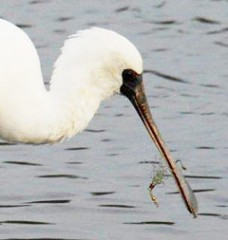
March 5, 2012 Ryukyu Shimpo
On March 4 in the southern part of Okinawa’s main island, a black-faced spoonbill, a species listed by the Ministry of Environment as “critically endangered” on its Red List, was found with a fishhook in its beak. A similar accident occurred four years ago, and on that occasion it took 38 days for the spoonbill to be saved. Those involved request that people fishing do not to throw away their hooks.
Shortly after 7:00am, when Kamenobu Oshiro from the Wild Bird Society of Okinawa found the black-faced spoonbill, he saw that a fishhook was hooked in its upper beak and that a piece of fishing line was wrapped around its beak. In the afternoon, something came off its upper beak, and the fishhook and the fishing line were hanging from its lower beak.
Throughout the day on March 4, people from the Wild Bird Society of Okinawa and Okinawa Veterinary Medical Association stayed to watch the bird. It was confirmed that the spoonbill could open its beak, however, as of 7:00pm that day it was not known if the spoonbill could actually swallow food after catching it.
Every year around November, black-faced spoonbills come to Okinawa for the winter. A marker was attached to this spoonbill in Korea to trace its migratory routes.
(English translation by T&CT, Megumi Chibana and Mark Ealey)
Go To Japanese
Slideshow of Black-faced spoonbill has its beak hooked in the same kind of accident that occurred four years ago
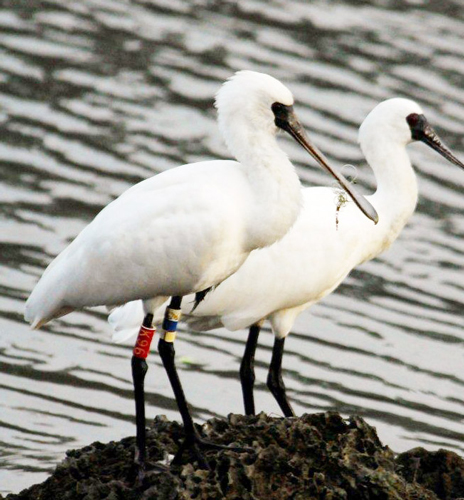
![[The Great East Japan Earthquake]<br>About 70 percent of evacuees in Okinawa feel “uneasy, but keen to return home”](http://english.ryukyushimpo.jp/wp-content/uploads/2012/03/20120316-01-01-175x175.jpg)
March 12, 2012 Ryukyu Shimpo
On March 11, a year will have passed since the Great East Japan Earthquake. The Ryukyu Shimpo conducted a survey of evacuees to Okinawa from Miyagi, Iwate, and Fukushima before March 1. The percentage of respondents who answered, “I feel uneasy, but keen to return home” was 71.2%. To the question, “How long are you going to stay in Okinawa? 43.9% of people answered “more than two years,” which includes 24.3% who answered, “reside permanently.” Because there are many evacuees from Fukushima, people seem to be fearful of the effects of radiation from the Fukushima Daiichi nuclear disaster, and therefore hesitate to return home.
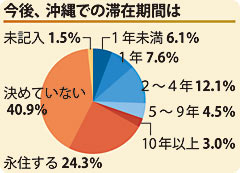
How long are you going to stay in Okinawa?
As many as 92.5% of respondents answered, “Okinawa is appropriate as an evacuation site,” and 34.9% would recommend that others move to Okinawa. Most people felt that “Okinawa is a good place to live,” followed by “the people are warm” and “there is relatively little risk of radiation contamination.”
According to the Okinawa Prefecture Department of Crisis Management and Disaster Prevention, Okinawa Prefecture and municipalities know of 987 evacuees from Miyagi (174 people = 17.6%), Iwate (nine people = 0.9%), Fukushima (691 people = 70.0%) and others (113 = 11.4%). From June last year, it has increased by around 20 to 70 people each month since the start of the survey by prefecture.
It is estimated that there will be an increase in evacuees who want to return home but are unable to do so, and evacuees recommending other people affected by the disaster to come to Okinawa.
An expert commented, “It is important not to allow these people to be isolated and to think about how we can create links between the evacuees and Okinawa. Providing ongoing support is necessary and it is time to re-evaluate the nature of that support.”
To the question, “How do you think about returning home?” 71.2% (47 families) answered, “I feel uneasy, but keen to return home.” “I want to go home” was 7.6% (five families), “I won’t go home” was 15.1% (ten families).
[Survey method] On February 15 and 16, the Ryukyu Shimpo distributed a questionnaire throughout the municipalities that offer refuge. The questionnaires were distributed at events at which the evacuees were expected to gather. There were responses from 66 families out of 177, representing a collection rate of 37.1%. Sixteen families are from Miyagi, two from Iwate and 48 from Fukushima.
(English translation by T&CT, Shinako Oyakawa and Mark Ealey)
Go To Japanese
March 4, 2012 Ryukyu Shimpo
At 12:00pm on March 4, in the grounds of the Shuri High School, Naha, a Self-Defense Force bomb disposal team disposed of an unexploded WWII U.S. Navy 8-Inch shell (about 118 kilogram, 90 centimeters long and 20 centimeters in diameter). Last November, workers found the unexploded shell when constructing a new building. This was the third case in Japan of a disposal by explosion in a residential area.
People at Josei Elementary School said that they heard the blast but could not feel anything. At 1:56pm, the traffic control and evacuation measures for residents were lifted.
(English translation by T&CT, Mark Ealey)
Go To Japanese
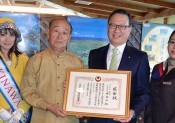
March 4, 2012 Ryukyu Shimpo
On March 3, Young-Doo Yoon, the president and CEO of Asiana Airlines, visited Okinawa to mark the 20th anniversary of the commencement of the airline’s service between Naha and Seoul. About 120 people including Korean media and people in the tourism industry accompanied him to Okinawa. Governor of Okinawa Hirokazu Nakaima held a meeting with Mr. Yoon and company executives, and a welcome ceremony at the Pacific Hotel Okinawa in Naha.
In the meeting with Governor Nakaima, President Yoon showed a photograph taken in 1992 when the company started the service to Okinawa. In the photo, the airline’s current chairman and Governor Nakaima, who was the deputy governor of Okinawa at that time, are together. With the governor welcoming him back after 20 years, President Yoon said, “I sense that we have a meaningful relationship.”
Asiana Airlines is the only company that has connected Okinawa and Korea since 1992. Okinawa has been gaining recognition because a Korean television drama was filmed there, and last December the airline increased its flights to Okinawa from five to seven times a week. The number of Korean tourists to visit Okinawa was 18500 in fiscal 2010, but it reached a record high of 18800 people in the ten-month period from April of 2011 to January 2012. The company has put a larger aircraft onto the Okinawa route since March 2 to coincide with the live performance by Korean singers in Naha on March 4 that is expected to attract 20000 people.
At the welcome ceremony, Governor Nakaima gave a speech, in which he said, “On behalf of all Okinawans, I would like to express my gratitude that Asiana Airlines has connected Korea and Okinawa for the past 20 years.” President Yoon stated, “Recognizing the importance of the service to Okinawa, we hope to maintain stable operations by expanding demand on both sides and through further product development.”
(English translation by T&CT, Lima Tokumori and Mark Ealey)
Go To Japanese

March 4, 2012 Ryukyu Shimpo
At the Okinawa Prefectural Youth Center on March 3, the Japan International Cooperation Agency (JICA) held a symposium entitled “Symposium on unexploded ordnance – Thinking about world peace from below.” Four panelists discussed the issue as it pertains to Okinawa, Cambodia and Laos and all participants agreed to promote nationwide awareness of the problem in Okinawa.
The director of JICA Okinawa International Center Toshihiro Obata said, “Unexploded ordnance poses a serious and ongoing risk to people in Okinawa. Everyone in Japan needs to be aware of this.”
Former member of the Japanese national soccer team Tsuyoshi Kitazawa, who is also an official supporter of JICA, remembered seeing disposal operations conducted in Laos and Cambodia. He said, “I heard an explosion when the operation was being carried out and it has stuck my mind.” Kitazawa commented that he has seen magnetic surveys to detect unexploded ordnance being carried out in Okinawa and went on to say, “People in the main islands of Japan do not know the reality of the situation in Okinawa.”
With regard to disposal of a U.S. artillery shell found on the site of the Ureshinogaoka-Samaritan Hospital in the Arakawa district of Haebaru last year, Yoshiaki Matsuno, senior officer Planning and Coordination of the Development Construction Department of the Okinawa General Bureau, said, “Safety of the residents is our main concern when disposing of this shell.”
Lao National Unexploded Ordnance Programme ,National Programme Director Bounpone Sayasenh said, “The U.S. military created the problem in Laos so the U.S. government should do something to solve it.”
(English translation by T&CT, Mark Ealey)
Go To Japanese
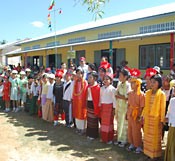
March 2, 2012 Ryukyu Shimpo
Shinken Ryosawa, the president of the Okinawa and Myanmar Friendship Association, presented a new elementary school to Labutta, a town located in the southwestern part of Myanmar.
Ryosawa, who was born in Myanmar, donated approximately five million yen towards the construction and furnishings of the elementary school.
Cyclones hit Myanmar in 2008 and 2010, destroying almost all of elementary schools in Labutta and killing many people. “Myanmar has been a democratic country since last March, and this makes it easier to support them.” Ryosawa said. “First, we wanted to help improve the education in Myanmar.”

On February 28, at the Ryukyu Shimpo offices, Ryosawa (middle in the front row), the president of the Okinawa and Myanmar Friendship Association, presented the funds for an elementary school to Myanmar.
The construction started in May and was finally completed last December, just in time for the school to start on January 4, the country’s independence day. Reinforced concrete was the main material used in the construction of the school, which has three classrooms.
The principal of the new school, presented a certificate of appreciation to Ryosawa for all of his hard work. Students, parents, and the people involved with the new school attended this event.
Eighty-seven orphaned children, some of whom lost their parents in the cyclones, are the first priority to be accepted into the school, making a total of 160 students. Ryosawa has important plans for the future of the school, adding a playground and medical support for the students.
In 1966, Ryosawa migrated to Taiwan from Myanmar because of the military control over the government. From Taiwan he moved to Okinawa where he has lived for 44 years. Ryosawa said, “I wanted to be an intermediary creating links between Okinawa and Myanmar. I hope that the children study hard.”
(English translation by T&CT, Lima Tokumori and Mark Ealey)
Go To Japanese
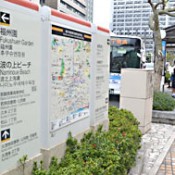
March 2, 2012 Ryukyu Shimpo
At the beginning of the 2012 fiscal year, the Okinawa Prefectural Government (OPG) will set up multilingual tourist information boards throughout Okinawa, including locations in Miyako and Yaeyama. The plan is to install a vicinity map giving tourist information at 40 sites, and about 200 guidance boards giving the distance and directions to certain sightseeing facilities. This large-scale installation of tourist information boards is the first initiative of this kind. It is expected to make it easier for the increasing numbers of foreign tourists, to expand tourism-related consumption, and to help discover new tourist spots.
Tourist information will be displayed in Japanese, Korean, Chinese, and English. Vicinity maps will mainly be installed around sightseeing sites, and will show the current location and the surrounding facilities. Guidance boards will be placed on roads.
The 2011 project has already seen electronic information boards giving tourist and traffic information on a touch-screen panel installed at the airport in Ishigaki City, the Ishigaki Harbor neighboring islands terminal, and at a public market.
According to an OPG survey, there are not enough vicinity maps, which are normally placed within 500 meters of a sightseeing spot, and only 58 boards are found in 340 popular sightseeing sites.
Japan has been affected by the decreased inbound tour demand due to the Great East Japan Earthquake, but the number of foreign tourists to visit Okinawa from April 2011 to January 2012 was 262,400, which is a 1.1% increase over the same period last year.
The number of foreign tourists is expected to continue to increase, and so there are strong calls to prepare to receive them.
On March 1 at a regular meeting of the Prefectural Assembly, tourism and sports official Daiichi Hirata explained, “We have installed information boards at roads, airports, ports, and other main sightseeing locations. In order to make it easier for the increasing number of foreign tourists we have experienced since 2009.” Making use of government subsidies, 125 million yen has been allocated in the fiscal 2012 budget. He explained in a response to a question from Akio Maejima of the Komei Party that a municipality subsidiary enterprise and 17 municipal governments that applied for project expenses will receive subsidies.
(English translation by T&CT, Megumi Chibana and Mark Ealey)
Go To Japanese
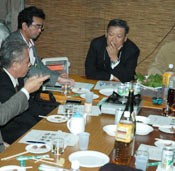
February 29, 2012 Ryukyu Shimpo
On February 17, a tasting session for smoked goat meat was held at the Tsukayama Awamori Brewery, a nationally designated cultural property in Onaka, Nago. The goat meat was cooked in a blasting range that Shigeru Ito, the principal of the Okinawa National College of Technology (ONCT), made when he was at Kumamoto University. Led by Deputy Mayor Kei Oyakawa, city officials of the Division of Industry and the Tourist Association enjoyed the smoked goat meat, which has an intense flavor and a soft texture. The ONCT has suggested that the goat meat of Katsuyama be used as a new local product of Nago, and has been aiming to cooperate with city authorities to promote it throughout Japan in future.
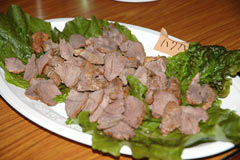
The smoked goat meat was cooked in a blasting range.
In the past it has been said that goat meat is not suited to the smoking process because it becomes tough when cooked, but the blasting range, which releases 3500 volts into hermetically sealed water and destroys the meat’s fibers by impact waves, makes it possible to maintain the meat’s tenderness even after it is cooked.
Cooking in the blasting range cuts the meat fibers and enriches amino acids, thereby increasing the juiciness of meat.
Using a sauce mixed with salts and a type of ginger as a flavoring and smoking the meat with chips of cherry blossoms made the very distinct smell of goat meat more acceptable for people from outside Okinawa.
Goat meat is low in fat and has fewer calories. Participants said, “It tastes great,” and “It’s more tender than I imagined it would be.”
Ito said, “I hope to launch a brand available all over Japan using the local products and resources of Nago. Selling smoked goat meat, cheese and an alcohol as a set menu, I hope to encourage healthy trends and offer the natural resources of Okinawa to people from other prefectures.”
(English translation by T&CT, Lima Tokumori and Mark Ealey)
Go To Japanese
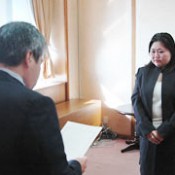
March 2, 2012 Ryukyu Shimpo
The Okinawa Prefectural Government (OPG) has hired Yukie Yoshikawa as a senior research fellow in the Regional Security Policy Division (provisional name), the new division to conduct research and gather information about Japan-U.S. security issues, which will be established in the Executive Office of the Governor in April. The OPG entered into an employment agreement with her on March 1.
The head of the Executive Office of the Governor, Susumu Matayoshi and Yoshikawa are scheduled to visit the United States for about one week from March 9 to meet intellectuals there. Matayoshi intends to invite them to participate in a discussion session with experts on security issues that will be held by the new division.
Yoshikawa will belong to the Military Base Affairs Division until the end of this month and will be engaged in the preliminary work to establish the new division.
A senior fellow at the Reischauer Center for East Asian Studies, Johns Hopkins School of Advanced International Studies, Yoshikawa intends to use her network in the United States to conduct research and gather information about Japan-U.S. security issues. With regard to the issues of the return and relocation of Futenma Air Station, she said, “I would like to go further than simply discussing where the base should be relocated. I would like to consider how to solve these issues on the basis of Japan’s defense and security arrangements in East Asia in general.”
During their stay in the United States, Matayoshi and Yoshikawa intend to gather information on the U.S. government’s movements regarding the review of the realignment of U.S. forces in Japan.
(English translation by T&CT, Mark Ealey)
Go To Japanese

March 4, 2012 Ryota Shimabukuro of the Ryukyu Shimpo
After three decades, 67 year-old Okinawan rock musician Katchan, or Katsuhiro Kawamitsu, closed his live music club “Jack Nasty” in Gate Street in Okinawa City (formerly Koza City). He was a popular vocalist in the rock group “Condition Green” which was organized in 1971 and went on to dominate the Okinawa music scene. Their radical and skilful performances attracted many American soldiers and young hot-blooded locals to his club, once a symbol of Koza Rock and Roll. Looking back, he said, “I have done well performing here. I have no regrets. The rock musician spirit is part of the essence of my soul. A musician can play his music wherever he goes, and I will now move on to the next stage.”
On the night of February 26 at Jack Nasty, Katchan’s last performance of the usual music and a humorous talk show attracted his close friends and followers. He performed slow tempo songs such as “What a Wonderful World” by Louis Armstrong, “The Dock of the Bay” by Otis Redding and other songs with the feeling of time passing by in leisurely fashion amid scenes of natural beauty. During the performance, he even enjoyed smoking a cigarette that he had wrestled from a guest. He used to play fierce songs and did radical things such as swinging a snake around as he walked through the American soldiers seated in the audience, but he said, “I have fallen in love with gentler songs during the past ten years.” The old rock & roll musician opened up and said, “The world is full of contradictions, and we have so many difficult problems to resolve. There seems no end to people seeking revenge. We should appeal to their senses without rejecting them, even though there may be soldiers out there killing their enemies, or people who belong to other races who speak different languages. We should feel what is around us. We are able to communicate with them.”
During the days when it was 300 yen to one U.S. dollar, Katchan said that he earned enough money from the club in one month to build a house, but the situation for musicians has changed in Koza, because in addition to the high value of the yen against the dollar, young people’s tastes in music have become more diverse. “If you get to the top of a mountain you have to come down. We just repeat that cycle, like the waves that lap on the shores of Okinawa,” he said. The old musician has no idea of quitting rock music quite yet.
He spent most of his music career at the club now packed with memories. One day, when young people with hearing difficulties came to the club he inspired them with his performance. He was also reunited with a young man visiting Koza, whom as a baby the young Katchan had held on the stage of a concert at the Nakano Sun Plaza in Tokyo in 1972. The old musician stated, “I will play rock & roll to appeal to people’s senses.” Sweat glistened on his face as he finished his performance at Jack Nasty.
(English translation by T&CT, Mark Ealey)
Go To Japanese
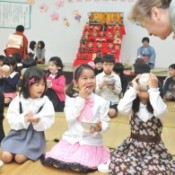
March 2, 2012 Ryukyu Shimpo
On March 2, the day before the Hina-matsuri or also known as the Doll’s Festival, a tea party was held at Oroku-Minami Kindergarten in Naha to pray for children’s growth and health. Hina dolls were on display for the children while they tasted different types of teas and ate snacks. Saki Kuniyoshi, a pupil, said, “I drank tea for the first time and the snacks were also very nice.”
(English translation by T&CT, Lima Tokumori and Mark Ealey)
Go To Japanese
![[The Great East Japan Earthquake]<br>About 70 percent of evacuees in Okinawa feel “uneasy, but keen to return home”](http://english.ryukyushimpo.jp/wp-content/uploads/2012/03/20120316-01-01-175x175.jpg)













 Webcam(Kokusai Street)
Webcam(Kokusai Street)


